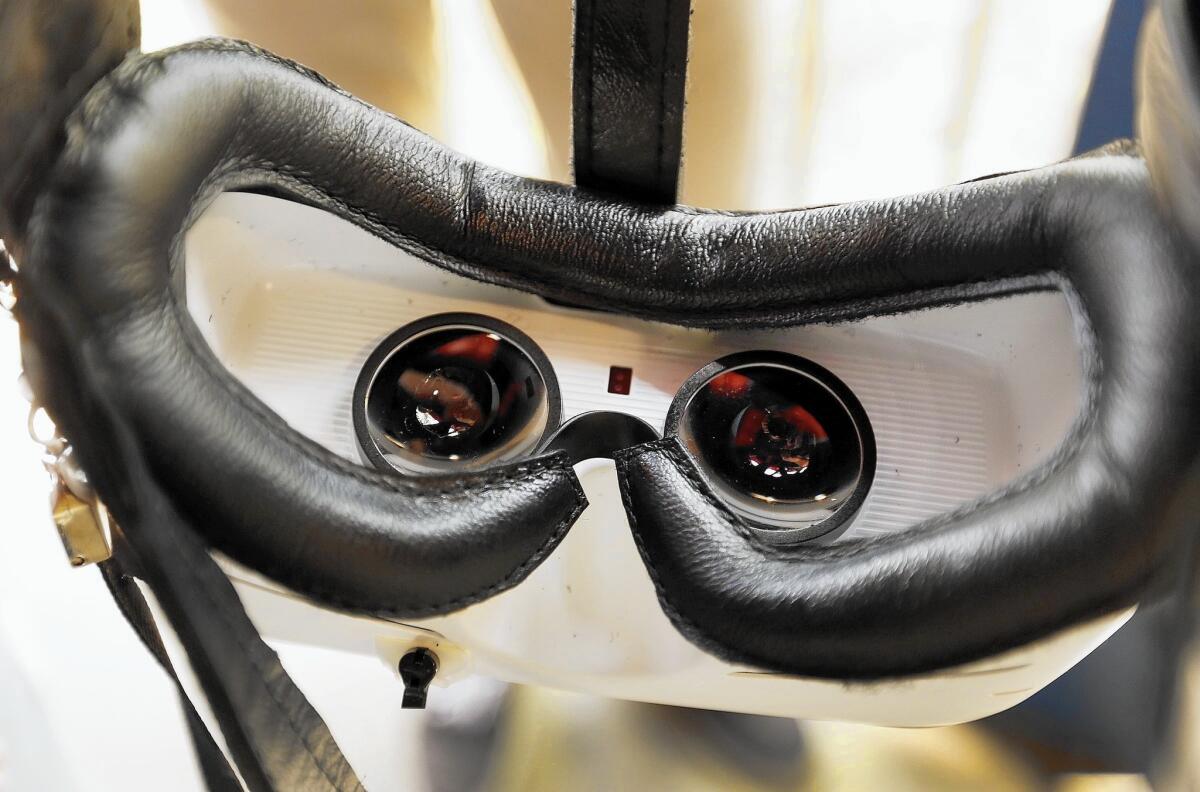The virtual reality era is ready for the living room. Will it be a iPhone-style game changer?

The brakes have officially been released on the virtual-reality era.
This week, Oculus’ $599 Rift headsets begin arriving on the doorsteps of consumers who pre-ordered the device in January. Two more high-end VR headsets are on the way, one from HTC and another from Sony, designed to work with the company’s PlayStation 4 home video game console.
And it’s been hard to miss Samsung’s commercials for its midlevel, Oculus-powered Gear VR headset, endorsed by rapper Lil Wayne and compatible with some of its mobile devices. Then there’s the low-cost Google Cardboard, which works with most any smartphone.
The race is on.
History will view the release of the Rift and other VR headsets as more important than the launch of the iPhone, according to Tim Sweeney, founder of Epic Games, best known for creating popular back-end software that drives many video games.
But just how successful VR will be in 2016 is a matter of debate. At the recent Game Developers Conference in San Francisco, the industry’s largest professional gathering, designer Jesse Schell theorized that 8 million top-level VR headsets will be sold by the end of 2017.
Maybe half that figure is more realistic, says J.P. Gownder, an analyst at Forrester Research. It’s been estimated that just 12 million to 13 million computers worldwide can actually run the technology.
Other industry watchers steer the conversation away from numbers and toward impact and an influential audience. Jason Rubin, who helps lead game development at Oculus, notes that initial VR efforts target technophiles and serious gamers rather than the mass market.
“There is a very large number of people who really like games and who really like graphics and who really like cutting-edge technology,” he said. “That’s our audience this year and next year.”
The pitch: The Rift will redefine mass media, conjuring worlds users can step into rather than passively view. “We’ve created a theme park,” said Rubin.
Proponents of VR speak longingly of a world in which headsets are as light and easy to wear as a pair of glasses. VR, they say, will alter everything from how we shop to how we view family photos to how we ride roller coasters.
Today, that’s not quite the reality. The Rift requires an expensive, high-end PC, one that must be tethered to via a cord, and its headset completely shuts off wearers from the world around them.
So before virtual reality changes the way we live, it will first have to change the way we game.
And when it comes to game design, get ready for the most approachable and untested time yet for the still-maturing medium. For in VR, almost everything we know about game development is wrong.
Blockbuster games rely on excitement and adventure. But in VR, excitement and adventure can lead to motion sickness. Developers say this glitch is an opportunity to create a new medium from the ground up — one dependent upon new forms of interaction.
“Of all the major games developed outside of VR, very few of them have any real possibility of working in VR,” said Epic Games’ Sweeney. Epic’s software the Unreal Engine drives many VR and non-VR experiences.
Though the market is relatively unproven, the public at least seems interested. Earlier this year, Google announced on its blog that it has shipped more than 5 million of its Cardboard viewers.
“It’s going to be a real revolution,” said Sweeney. “It’s going to be a bigger one than the personal computer or the smartphone revolution. It’s the first medium that has any potential of making you feel like you’re somewhere else. We’ve gotten pretty good at drawing images of other places on screen, but immersing you in it is a completely new thing.”
One we haven’t quite figured out.
Adam Orth, whose Santa Monica-based Three One Zero will release the tense, lost-in-space game “Adr1ft” for the Rift, admits that navigating the new medium was all something of an experiment.
“We didn’t know anything. It was basically like peering around in the dark with a torch and hoping for treasure and hoping not to find dragons,” he said.

A teaser trailer for “Trials on Tatooine,” a virtual reality experience developed by Lucasfilm’s ILMxLAB.
“We have these brand-new ways to communicate and touch and tell stories,” Orth added. “It’s exciting, and it’s terrifying. You have to basically throw out everything you know.”
But is the public ready to be VR guinea pigs?
You’d be forgiven for believing you’ve heard the VR propaganda machine before.
In the mid-’90s, virtual reality appeared destined to leap out of science fiction films and university labs and into our households. Video-game powerhouse Nintendo even released a device, the Virtual Boy, a clumsy, tripod-looking contraption in which games were confined to red and black tones. It came and went quicker than it could become a punch line.
The Rift, advocates say, is a different story.
Before Oculus, maker of the Rift, was acquired for about $2 billion in 2014 by Facebook, the company was essentially the vision of Palmer Luckey. The home-schooled Long Beach native, who briefly studied journalism at Cal State Long Beach, spent his teen years building sometimes dangerous experiments — a coil gun here, a laser there.
His hobbies were funded by fixing mobile phones. Luckey in 2013 told The Times that when he was 16 he pulled in at least $36,000 by repairing iPhones and selling unlocked phones on Internet message boards for $700 apiece. And while he dreamed of being a tech journalist, Luckey in 2012 turned to crowd-funding site Kickstarter in the hopes of selling do-it-yourself VR kits.
Initial Rifts were essentially held together with duct tape and glue.
Still, the Rift early on distinguished itself by taking advantage of gains made by the mobile industry, helping to make the technology relatively affordable. Software is also now powerful enough to correct for lens distortion, and motion-control advancements better allow for head tracking and cut down on delays in response time, meaning the images on the Rift screen move with the tilt of the player’s head.
To step into the Rift game “Lucky’s Tale” is akin to being transported to a world that’s part “Super Mario Bros.” and part “Looney Tunes.” A bright, fantastical forest-lined universe is laid before the player, who towers over the landscape like the puppeteer of a live-action board game.
More important, “Lucky’s Tale” is simple, doing away with complex control schemes that have made PC and console video games impenetrable to those not already in the know. Our guide through the game, an adorable fox named Lucky, walks and jumps at largely a leisurely pace, and the camera is the player’s head.
“Lucky’s Tale” is the creation of Paul Bettner, chief executive of McKinney, Texas-based Playful Corp. and a game designer best known as a principal architect of iPhone smash “Words With Friends.” Bettner left mobile for VR, and he says he’s not returning.
“It’s more a question of how fast the acceleration will happen,” he said, “and not a question of will we go back into a phase where people say, ‘That was neat. What’s the next thing?’ This is the beginning of something that will not go backward.”
And those who don’t buy in this year may soon find VR to be relatively inescapable.
Six Flags Magic Mountain will on April 21 open to the public a VR makeover of its Revolution coaster. Visitors will wear the Samsung Gear VR headset, which will transport viewers into a lighthearted alien-invasion video game. Marketers have also taken to VR, as automakers are developing virtual showrooms and virtual test drives.
“There are nearly unlimited uses here beyond the well-known ones of gaming and media and all that, in areas like marketing, healthcare and data visualization,” said Forrester’s Gownder.
And yet, Bettner warns not to get caught in the hype.
“I can expect somewhat of a period of disenchanting stories,” he said. “You can’t help it. There’s always an element of hype that can get out of scale with reality. That will be a matter of somebody saying, ‘Well, we expected it to see this many millions, and it sold this many millions.’ The start might be a little slower than people expect, but it is the start of something that will not ever slow down.”
ALSO
First look at ‘Star Wars’ virtual reality experience brings Kylo Ren and Luke Skywalker together
Six Flags Magic Mountain turns aging coaster into virtual reality video game
Robert De Niro reverses course, yanks anti-vaccine film from Tribeca lineup
‘Orphan Black’ co-creators discuss going back to the beginning for Season 4
In the superhero movie arms race, has Warner Bros. created too bleak a world in ‘Batman v Superman’?
More to Read
The biggest entertainment stories
Get our big stories about Hollywood, film, television, music, arts, culture and more right in your inbox as soon as they publish.
You may occasionally receive promotional content from the Los Angeles Times.











